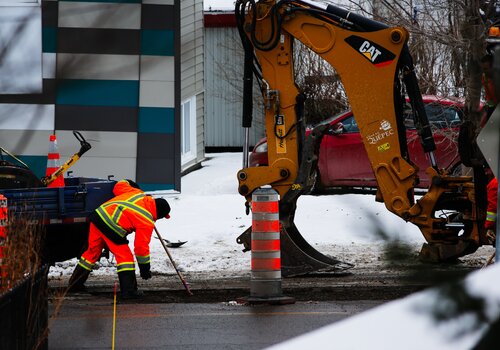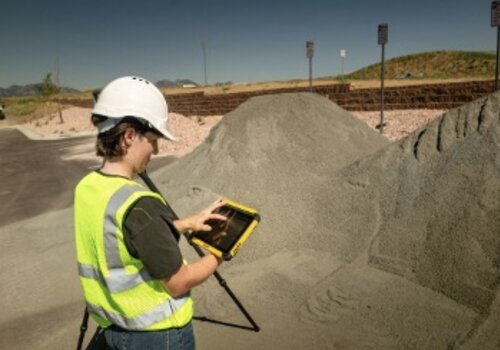When temperatures drop, even the best-run jobsite can be caught off guard. Frozen hydraulics, slick walkways, supply delays and labor slowdowns cost money and time. Contractors need to have a plan for winter before the cold hits. Here’s what you need to know before the first hard freeze.
START WITH EQUIPMENT AND FLEET READINESS
Cold weather doesn’t just slow workers; it challenges the machines they depend on. Low temperatures can increase equipment breakdowns and repair costs.
Contractors should winterize equipment long before freezing conditions arrive. The Construction Management Association of America recommends completing fleet checks at least six weeks before sustained cold.
That includes:
-
Swapping to cold-rated oils, lubricants and antifreeze
-
Testing block heaters and installing battery warmers
-
Draining and protecting water lines and pneumatic systems
-
Storing equipment indoors or under covers when idle
Pro Tip: One commonly overlooked step is fuel management. Diesel begins to gel around 10°F (-12°C). Treating tanks and portable fuel storage with anti-gelling additives can prevent job-site shutdowns that ripple through a project schedule.
PREPARE THE SITE, NOT JUST THE SCHEDULE
Frozen materials, reduced daylight and surface ice can quickly make a safe site unsafe.
Contractors should plan for:
-
Ground protection: Insulate or tent excavation areas to prevent frost heave.
-
Concrete curing: Use thermal blankets or heated enclosures for pours.
-
Lighting: Supplement natural light as days shorten.
-
Material storage: Keep moisture-sensitive materials like drywall, lumber, and insulation off the ground and under cover.
Pro Tip: Don’t forget about stormwater management. Winter rain and meltwater can overwhelm site drainage if sediment control systems are frozen or clogged. Cleaning and inspecting these systems before freeze-up saves costly rework later.
PROTECT AND PREPARE YOUR WORKFORCE
Worker readiness is just as critical as equipment readiness. OSHA notes that employers must know the warning signs and provide protection against cold-stress hazards such as hypothermia and frostbit. That means more than handing out gloves; it requires a site-specific cold-weather safety plan.
Consider adding “cold-weather toolbox talks” throughout the winter season. These short check-ins reinforce awareness and keep cold safety top of mind.
Checklist for winter workforce readiness:
-
Supply insulated, water-resistant PPE rated for expected conditions
-
Stagger outdoor tasks to limit extended cold exposure
-
Establish heated shelters for breaks
-
Schedule work for daylight hours when possible
-
Provide training on recognizing and reporting cold-stress symptoms
Pro Tip: Download these free winter safety infographics to share with crews and online.
ADDRESS THE LESS-OBVIOUS RISKS
Supply Chain & Scheduling: It’s easy to plan for snow days but not for vendor delays. Cold weather affects everything from material deliveries to subcontractor availability. Be sure to include winter weather contingencies in contracts and scheduling. Build float time into project plans and clarify responsibility for weather-related costs.
Insurance & Risk Transfer: Many firms overlook how freezing damage or extended downtime interacts with their insurance policies. Some property or builder’s-risk coverage excludes damage caused by inadequate winterization. Review policy language now to confirm what’s covered, and document your preventive actions in case of claims later.
Cash-Flow Management: Winter months can compress revenue. Plan ahead by forecasting cash flow under different scenarios like delays, reduced hours or postponed starts. Using this data, negotiate supplier terms or adjust draw schedules early rather than reacting mid-season.
Technology & Remote Monitoring: Smart job-site cameras and IoT sensors now play a bigger role in winter. Use remote monitoring to track equipment health, temperature and site conditions in real time. Contractors who integrate these tools can respond faster to freezing events, protecting both assets and schedules.
USE THE OFF-SEASON STRATEGICALLY
When outdoor production slows, leading firms focus inward. Training, process reviews and preventive maintenance all pay dividends once warmer weather returns.
The most successful contractors use winter downtime to:
-
Refresh safety certifications
-
Calibrate equipment and replace worn components
-
Update bid templates and digital workflows
-
Strengthen client relationships through check-ins or maintenance services
This strategic downtime helps reduce spring ramp-up chaos and keeps your workforce engaged during the slower months.
THE TAKEAWAY
Winter’s impact on construction is inevitable but preventable losses are not. The difference between profit and pain often comes down to readiness. Contractors who check equipment before it fails, prepare crews before the cold hits and plan budgets before delays arrive can work more safely and deliver more during the winter season.
Discover more maintenance solutions in a hands-on setting at CONEXPO-CON/AGG 2026 during our new workshop, Shop Talks and Walks: Equipment Maintenance Demos.
Photo credit: SHUTTERSTOCK/PASCAL HUOT












